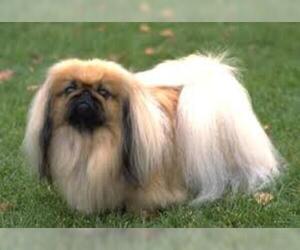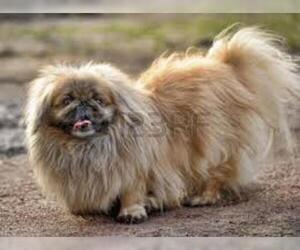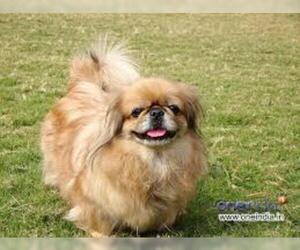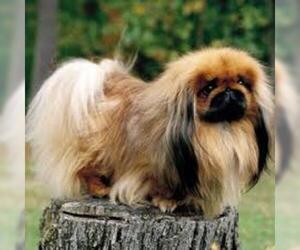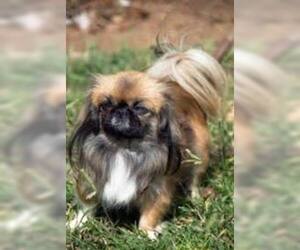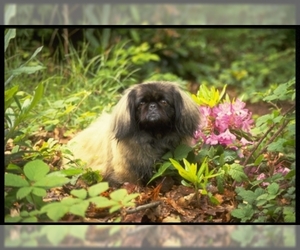
All about Pekingese dog breed
A.K.A. :Lion Dog, Chinese Lion Dog, Foo Dog, Beijingese, Sleeve Dog, Peke, Peking Palasthund, chien Pékinois, perro pekinés, pekinés, Pekinese, Pejing, Short-nosed Lion Dog, Sun Dog, Imperial Dog, Royal Dog, Tiny Lion, Half-pint Lion, Dog of the Forbidden City
Size
Grooming requirements
Exercise requirements
Good with other dogs
Watchdog ability
Energetic
Training requirements
Playful
Affectionate
Good with other pets
Good with children
Good with strangers
Winter
Summer
Healthiness
Protective
Life Span
| Pure Breeds | Member |
| Breeds A - Z | P |
| Breeds by Group | Companion Toy |
| Breeds by Trait | Low Shedding |
| Overview: | The Pekingese is a captivating toy breed with a rich history, originating in ancient China where they were revered companions of royalty. Known for their distinctive "lion's mane" and rolling gait, they possess a compact, sturdy body covered in a long, profuse double coat that requires regular grooming to prevent matting. Their most recognizable features include a flat face, large, dark eyes, and a short, broad muzzle. Temperamentally, Pekingese are brave, independent, and surprisingly dignified, often displaying an affectionate but not overly demonstrative loyalty to their owners. They adapt well to apartment living due to their small size and relatively low exercise needs, though they do enjoy short, supervised walks. While generally good with older, respectful children, their independent nature means they might not be the ideal choice for boisterous family environments. Health-wise, their brachycephalic (flat-faced) structure makes them prone to respiratory issues and heatstroke, so vigilance in warm weather is crucial. Overall, the Pekingese is a charming and unique companion for those seeking a devoted, somewhat regal lapdog. |
F.A.Q.
All You Need to Know About the Pekingese Breed
The Pekingese is a dignified and charming companion originating from ancient China, cherished by royalty for centuries. These small, sturdy dogs boast a distinctive "lion's mane" coat, a flat face, and large, expressive eyes. Known for their independent yet affectionate temperament, Pekingese are loyal to their families and can be surprisingly bold despite their size. They are well-suited for apartment living and families with older children, as they prefer a calm environment. Their thick double coat requires regular grooming to prevent matting, though their exercise needs are minimal – short daily walks suffice. Potential health considerations include brachycephalic airway syndrome due to their flat faces, and eye issues. If you're seeking a captivating and relatively low-energy canine companion, the Pekingese could be your perfect match.Pekingese Weight: Adult Pekingese typically weigh between 7 and 14 pounds. While there's no significant average size difference between males and females, individual dogs can vary within this healthy weight range for Pekingese. This average weight for Pekingese makes them a compact and portable breed.
Pekingese Height: How Tall is a Pekingese?
If you're wondering about the average height of a Pekingese, you've come to the right place! These charming little dogs are known for their compact size and sturdy build. When measured at the shoulder (the highest point of their back, between the shoulder blades), the typical adult Pekingese height falls within a fairly consistent range.The average size for a Pekingese is generally:- 6 to 9 inches tall at the shoulder.
Pekingese Colors: A Comprehensive GuidePekingese boast a wide array of beautiful Pekingese colors, offering options for every preference. The American Kennel Club (AKC) and other major kennel clubs recognize most coat colors and markings, with the exception of albino and liver. This means you'll find a rich diversity among AKC recognized Pekingese colors.Common and AKC Recognized Pekingese Colors:* Black: A deep, solid black, often with a glossy sheen.* Brindle: A striking pattern of dark stripes on a lighter background, often fawn or red.* Cream: A soft, pale yellowish-white, very popular for its elegant appearance.* Fawn: A warm, light brown, often seen with a darker mask.* Red: A vibrant, rich reddish-brown, a classic Pekingese color.* Sable: Dark-tipped hairs on a lighter base, creating a shaded effect.* White: A pure, snowy white coat, highly sought after.Beyond these solid and patterned coats, Pekingese colors also include various combinations and markings:* Black and Tan: A distinct pattern of black with tan points on the muzzle, chest, and legs.* Parti-color: Any recognized color with white markings, often seen as patches.* Self-black: A solid black coat without any other markings.* Sleeve Pekingese: While not a color, this term refers to a smaller Pekingese, often coming in various accepted colors.Rare and Exotic Pekingese Variations:While not officially recognized by all major kennel clubs, some rare coat types and exotic Pekingese variations exist due to specific genetics. These colors can be more difficult to find and may command a higher price:* Blue: A diluted black, appearing as a grayish-blue.* Chocolate (Liver): A recessive gene results in a brown-pigmented Pekingese, including the nose and paw pads.* Lilac (Isabella): A diluted chocolate, appearing as a pale, grayish-brown.* Merle: A distinctive pattern of irregular patches of diluted color and solid color, often with blue or odd-colored eyes. Merle is a highly debated color in many breeds due to potential health concerns associated with the gene.When searching for a Pekingese, understanding these Pekingese colors and their recognition status can help you make an informed decision, especially if you plan to show your dog. Always inquire about the puppy's lineage and health clearances, especially when considering rare coat types.
The Pekingese personality is a captivating blend of independence and affection. While often appearing dignified and aloof, they are deeply devoted to their families, displaying fierce loyalty. Their temperament of Pekingese makes them generally not the most outwardly friendly with strangers, preferring the company of their chosen people. They are highly adaptable to apartment living due to their relatively low exercise needs and thrive in quiet, comfortable environments. Pekingese can be good with older, respectful children who understand their need for personal space, but their small size and independent nature mean they may not be the best choice for very young, boisterous kids. Similarly, while they can co-exist with other calm pets, their sometimes dominant nature means careful introductions are necessary, and they often prefer to be the sole pampered pet. They are intelligent and can be stubborn, requiring patience and consistent, positive reinforcement in training.
The Pekingese temperament is known for being loyal, affectionate, and surprisingly regal for their small size. They are excellent companion dogs, thriving on close human companionship and forming strong bonds with their families.While generally friendly with their own people, they can be reserved or independent with strangers. Sociability with other pets depends on early socialization; they can get along well with other dogs and cats, but their proud nature means they might prefer being the only pet or being with other docile companions.Pekingese are highly adaptable and excel in apartment living, requiring minimal exercise beyond short walks or indoor play. They are not overly active but do enjoy a bit of playtime.Regarding behavior with children, they are generally best suited for homes with older, respectful children who understand how to interact gently with small dogs. Their sensitive nature means they don't appreciate rough play or being treated like a toy, and they may be prone to snapping if provoked or feeling threatened.They possess a distinct stubborn streak and a mind of their own, making consistent, positive reinforcement training essential. Despite their independent nature, they are also quite sensitive to their owner's emotions and require a calm, loving environment. Their independent personality traits contribute to their unique charm and make them fascinating, devoted companions for those who appreciate their dignified yet loving disposition.
Pekingese Care: Daily Maintenance and Health TipsCaring for a Pekingese involves consistent attention to their unique needs. Grooming needs are substantial: their long, double coat requires daily brushing to prevent matting and remove loose hair. Expect regular professional grooming every 6-8 weeks for trimming and tidying. Exercise limitations are key; Pekingese are a low-energy dog breed and prone to overheating. Short, gentle walks are sufficient, avoiding hot weather or strenuous activity.Dietary considerations for a Pekingese focus on portion control to prevent obesity, a common issue. High-quality kibble formulated for small breeds, with appropriate calorie intake, is recommended. Regular dental check-ups and at-home dental care (brushing) are crucial to combat periodontal disease.Due to their brachycephalic (flat-faced) anatomy, wrinkle and ear cleaning are essential. Daily wiping of facial folds prevents skin infections, and ears should be checked and cleaned weekly. Their brachycephalic nature also leads to climate sensitivity. Pekingese struggle in heat and humidity; provide a cool environment and limit outdoor time during warm weather.Common health concerns in Pekingese include respiratory issues, eye problems (due to prominent eyes), patellar luxation, and skin issues within their folds. Regular veterinary check-ups are vital for early detection and management. Weight management is paramount to prevent strain on their joints and exacerbate respiratory problems. Understanding how to care for a Pekingese involves dedication to their grooming, controlled exercise, careful feeding, and proactive health monitoring.
Pekingese Activity Level: How Active are Pekingese?The Pekingese activity level is generally low, making them an excellent choice for less active individuals or those living in apartments. While they do enjoy short bursts of playful energy, they are primarily a breed that prefers comfort and companionship over strenuous activity.Typical Energy Levels: Pekingese are known for their calm and dignified demeanor. They are not a high-energy breed that requires extensive outdoor adventures. Their energy levels are typically moderate to low, with a preference for indoor activities and plenty of rest.Daily Exercise Needs: Despite their calm nature, Pekingese still require daily exercise, though it's minimal. Short, leisurely walks of 15-20 minutes, once or twice a day, are usually sufficient to keep them healthy and happy. Leash walking is recommended due to their tendency to wander and their delicate structure. It's crucial to avoid over-exercising them, especially in warm weather.Playtime Preferences: Pekingese enjoy gentle playtime with their owners. They may engage in short bouts of chasing toys or wrestling with a favorite stuffed animal. However, their playtime is usually brief, followed by long periods of napping or lounging. They appreciate interactive toys that stimulate their minds without requiring excessive physical exertion.Limitations Due to Brachycephalic Anatomy: A significant factor influencing the Pekingese activity level is their brachycephalic (short-nosed) anatomy. This characteristic makes them prone to respiratory issues, particularly in hot or humid weather. Overheating is a serious concern, so strenuous exercise, especially during peak temperatures, must be strictly avoided. They are not suitable for jogging partners or intense outdoor sports. Always monitor their breathing during any activity and provide access to fresh water.Balance of Energy and Rest: Pekingese perfectly balance short bursts of playful energy with long, luxurious periods of rest. They are content to relax by your side for hours, making them ideal lap dogs.Suitability for Families: Due to their low exercise needs, Pekingese are suitable for low-energy households and individuals who prefer a more relaxed lifestyle. They can adapt well to families with older, respectful children but may not be the best fit for very active families seeking a dog to join them on long hikes or runs. If you're looking for a calm, affectionate companion who enjoys a leisurely pace of life, the Pekingese might be the perfect match.
Breed Breakdown: What Experts Say About the Pekingese
I'd rate the "Size" trait of the Pekingese breed at a 2.Pekingese are undeniably a very small breed. They typically stand between 6 to 9 inches tall at the shoulder and weigh a mere 7 to 14 pounds. Their compact, sturdy body, though appearing somewhat substantial due to their abundant coat, is truly miniature. When compared to other companion dogs, they firmly fall into the toy group, making them significantly smaller than even medium-sized breeds like Beagles or larger companion dogs such as Golden Retrievers. This diminutive size makes them exceptionally well-suited for apartment living, frequent travel (often fitting comfortably in an airline-approved carrier under a seat), and households with limited space. They require very little physical footprint and adapt easily to confined environments.
I would rate the grooming requirements of the Pekingese as an 8 out of 10.While not quite an extreme 10, they are undoubtedly very high-maintenance compared to most companion dogs. Their luxurious double coat, a defining feature, is the primary reason for this high rating. It sheds moderately year-round but requires daily brushing to prevent matting, especially in the long feathering around their legs, tail, and ears. Without consistent attention, mats can quickly become painful and lead to skin irritation. Beyond the coat, their brachycephalic (flat) face often comes with skin folds that need regular cleaning and drying to prevent bacterial growth and irritation, contributing to a susceptibility to skin issues. Their long, pendulous ears also require routine checking and cleaning to prevent infections. Nail trimming needs to be done frequently due to their relatively small size and often indoor lifestyle, and they generally require professional or at-home bathing at least once a month, which can be a significant undertaking given their coat. Their delicate nature and potential for allergies also mean that some specialized shampoos or skincare might be necessary. This combination of daily coat care, specific attention to skin folds, and regular general maintenance makes them far from an easy-care breed.
I would rate the exercise requirements of the Pekingese as a 2 out of 10.This rating reflects their remarkably low physical demands. Pekingese are a distinctly brachycephalic breed with short legs and a sturdy build, not designed for strenuous activity. Their daily needs are typically met with short, gentle walks – often no more than 15-20 minutes, once or twice a day – and indoor playtime. Their energy levels are low, and they have very limited tolerance for sustained movement, especially in warm or humid weather, due to their compromised respiratory systems. They are absolutely unsuitable for high-impact activities like agility or extended jogging. Instead, they thrive with minimal activity, preferring to lounge and enjoy the comfort of their home. While they do benefit from some mental stimulation through short play sessions and puzzle toys, structured exercise routines are largely unnecessary and can even be detrimental to their health, particularly concerning their breathing. Their primary exercise focus should be on short, low-intensity activities to maintain a healthy weight and provide fresh air without overexertion.
I'd rate the Pekingese breed's "Watchdog Ability" at a 7. While not physically imposing, Pekingese are surprisingly alert and possess a keen awareness of their surroundings. They are quick to bark at unfamiliar sounds, people approaching the door, or anything they perceive as out of the ordinary, making them excellent "doorbell" dogs. Their territorial instincts are strong, and they are not shy about letting you know if someone is near their space. This consistent barking serves as a meaningful early warning system, often deterring potential intruders who prefer to avoid detection. While they won't physically engage an intruder, their persistent vocalization is a clear signal that the household is aware of their presence, shifting them from a purely passive companion to a capable provider of significant early warnings in a home environment.
I would rate the "Good with Other Dogs" trait of the Pekingese breed a 4.Pekingese are generally known for their independent and sometimes possessive nature, which can translate to a cautious, if not aloof or even dominant, attitude towards other dogs. While a well-socialized Peke can coexist peacefully, especially with dogs they've grown up with or those that respect their space, they aren't typically the breed to enthusiastically greet every canine they meet. They may be intolerant of overly boisterous or pushy dogs, regardless of size, and their small stature doesn't diminish their willingness to stand their ground. Introductions to unfamiliar dogs, particularly in new environments, often require careful management and supervision to prevent territorial displays or squabbles. They don't inherently thrive in large, active canine groups and may prefer the company of a select few, if any, canine companions. Therefore, they require careful introductions and consistent training to coexist peacefully, rather than naturally blending into a multi-dog household without effort.
I would rate the "Energetic" trait of the Pekingese breed as a 2 out of 10.The Pekingese is renowned for its extremely low energy levels, making it one of the most laid-back and least demanding companion dogs when it comes to physical activity. They typically have a very low activity level, preferring short, leisurely strolls or simply lounging. Their endurance is minimal, and they are not particularly playful in the high-octane sense, often content with a gentle tug or a brief chase of a toy rather than extended play sessions. There is very little need for significant physical stimulation; a few short walks a day and some indoor pottering are usually more than sufficient.Their brachycephalic (short-nosed) anatomy significantly affects their stamina and exercise tolerance. This unique facial structure can lead to breathing difficulties, especially in warmer weather or during strenuous activity, making them highly susceptible to overheating and respiratory distress. Consequently, they are entirely unsuitable for participation in outdoor or athletic activities beyond the most minimal of exertions. Their natural inclination is to conserve energy, and their physical limitations reinforce this disposition, making them ideal for individuals seeking a truly sedentary companion.
I'd rate the Pekingese's "Training Requirements" a 7 out of 10.While not impossible to train, the Pekingese definitely leans towards the more demanding end of the spectrum, making them less beginner-friendly and more suited for experienced owners who understand canine psychology and are prepared for a structured, consistent routine. Their intelligence is moderate, but it's often overshadowed by a significant stubborn streak and an independent nature that makes them appear to have a short attention span when they've decided they're not interested. Responsiveness to commands can be inconsistent; they often seem to weigh whether cooperating is worth their effort or if they can get away with ignoring you. Positive reinforcement is crucial, but even with high-value treats and praise, you'll need immense patience and consistency to see results. They require handlers who are firm yet gentle, understanding that harsh methods will only make them more resistant. Expect to invest considerable time and effort into house-training, basic obedience, and leash manners, as their dignified and sometimes aloof personality means they're not naturally eager to please.
I would rate the Pekingese's "Playful" trait as a 4 out of 10.While they can certainly have their moments of playful bursts, especially when they're puppies or if they're particularly attached to a favorite person or toy, the Pekingese is generally a more laid-back and dignified breed compared to many other companion dogs. They aren't typically known for high energy levels, a strong desire for constant games, or boisterous, attention-seeking antics. Their love for games and interaction is often on their own terms and in short bursts rather than sustained periods. They might bat at a toy for a minute or two before settling back into a comfortable spot. Their enthusiasm in daily life is more likely to manifest as quiet contentment and enjoyment of their human's company rather than effusive displays of energy. They prefer snuggling on a lap or a leisurely stroll over an energetic romp in the park, making them more naturally calm than spirited.
The Pekingese breed, with its regal history and charming personality, rates a solid 7 on the affection scale. While they certainly appreciate and desire human companionship, they aren't always overtly demonstrative in the way some other companion breeds might be. Their affection is often expressed with a quiet devotion rather than boisterous enthusiasm.They do enjoy physical closeness, particularly lap-sitting and being held, and can be quite the snugglers once they've deemed you worthy of their affection. Loyalty is a hallmark of the Pekingese; once they bond with their person, they are steadfast and protective, often displaying surprising bravery despite their small size. They are quite sensitive to the emotions of their owners, often offering a comforting presence during times of distress, though their reaction might be a gentle nuzzle rather than an exuberant lick. While they won't typically be underfoot constantly, they do enjoy following their family members from room to room, preferring to be in the same vicinity.The Pekingese thrives on affection and close bonds but maintains a certain independent streak. They appreciate being pampered and adored, but their love is a refined, almost dignified kind of affection. They are not clingy, but they are deeply devoted to their chosen people, making them a wonderfully loving companion for those who appreciate their unique blend of independence and heartfelt attachment.
I would rate the "Good with Other Pets" trait of the Pekingese as a 6 out of 10.While not inherently aggressive, the Pekingese is a breed that often prefers to be the center of attention and can exhibit a surprisingly strong personality for its small size. Their prey drive is generally low, making them less likely to chase cats or other small pets, which is a significant positive. However, their resource guarding tendencies can be moderate, particularly when it comes to food, toys, or even their human's lap. They can be quite possessive and may not appreciate sharing these things with other animals.When it comes to other dogs, particularly larger or more boisterous ones, a Pekingese might be intimidated or, conversely, attempt to assert dominance despite its size. They are not naturally pack animals and often prefer the company of humans. Early and consistent socialization is absolutely crucial for a Pekingese to coexist peacefully in a multi-pet household. Without it, they can become quite territorial and even snappish towards other pets. They generally require careful introductions, supervision, and ongoing training to ensure harmonious relationships. They are adaptable if properly socialized, but it's not a trait that comes effortlessly to the breed; it's more a result of dedicated effort from their owners.
I'd rate the Pekingese's "Good with Children" trait a 3 out of 10.While not inherently aggressive, Pekingese are generally not a breed well-suited for families with young children. Their independent and often "regal" temperament means they have a low tolerance for the boisterous play, noise, and sometimes clumsy handling that comes with kids. They are not known for their patience or playfulness, preferring a calm and quiet environment. They can be easily overwhelmed and may nip if they feel their personal space is invaded or if they are handled roughly. While older, respectful children who understand how to interact gently with a small, delicate dog might be okay, the Pekingese is naturally more suited to a household of adults or very quiet teenagers. They are not naturally gentle and affectionate in the way many child-friendly breeds are, and while training can help with basic manners, it won't fundamentally change their low tolerance for typical child-like behavior. Supervision is definitely required, and even then, it's often more about managing the child's interaction to protect the dog rather than the dog thriving with the child.
The Pekingese breed typically rates a 3 for "Good with Strangers."While some individual Pekingese can be more tolerant, the breed generally leans towards being highly reserved and often quite aloof with unfamiliar adults. They are not naturally outgoing and welcoming to strangers; instead, they often view them with a suspicious or indifferent air. This isn't usually due to unfriendliness in an aggressive sense, but rather a strong preference for their inner circle and a lack of inherent desire for new acquaintances. They are more likely to ignore strangers, perhaps offering a low growl or a brief bark if the stranger approaches too quickly or too closely, rather than greeting them with enthusiasm. They possess a degree of ancient dignity and a watchful, almost regal demeanor that extends to their interactions with outsiders. While early and consistent socialization can help them be more tolerant and less stressed in guest-filled environments, it rarely transforms them into a truly sociable or welcoming dog with strangers; it primarily helps them be more comfortable rather than genuinely friendly. Their adaptability in public often depends on the individual dog's comfort level with new sights and sounds, but their inclination to reserve themselves with unfamiliar people remains.
I would rate the Pekingese's "winter" tolerance as a 2.Pekingese are extremely sensitive to cold due to a confluence of factors. Their long, dense double coat might seem protective, but it's not sufficient to counter their small size, which translates to a high surface area to volume ratio, leading to rapid heat loss. They possess very little body fat for insulation. Critically, their brachycephalic anatomy makes them highly susceptible to respiratory issues and hypothermia in cold weather. They struggle to regulate their body temperature and are prone to chilling quickly. Even short exposures to cold can be dangerous, increasing the risk of respiratory infections and hypothermia. They absolutely require special care during winter months, far more so than most other companion dogs. Outdoor activity should be severely limited to very short, supervised potty breaks, and they should be bundled in protective clothing when venturing outside. Extended playtime in cold climates is unsafe and not recommended for this breed.
The Pekingese breed has a "Summer" tolerance rating of 1. This indicates extreme sensitivity to heat.Their brachycephalic (short-nosed) anatomy severely compromises their ability to regulate body temperature. The elongated soft palate and narrowed nostrils restrict airflow, making it very difficult for them to cool down through panting, which is a dog's primary method of heat dissipation. This makes them highly susceptible to heatstroke, even in moderately warm temperatures. They require significant climate control during hot weather, often needing air conditioning indoors. Outdoor activity should be severely limited to short, shaded walks in the very early morning or late evening, or preferably avoided altogether when temperatures rise. Compared to other companion dogs, Pekingese require extremely special care in summer months, more akin to keeping an infant safe from the heat, as they cannot tolerate conditions that many other breeds would find only mildly uncomfortable.
I would rate the "Healthiness" trait of the Pekingese breed at a 3 out of 10.Pekingese are unfortunately a breed with significant health challenges, placing them firmly on the higher-maintenance side of companion dogs, rather than being robust. Their distinctive, brachycephalic (flat-faced) head structure is a primary contributor to a range of breathing difficulties, collectively known as Brachycephalic Obstructive Airway Syndrome (BOAS). This can manifest as noisy breathing, snoring, difficulty exercising, and even heat stroke due to their inability to effectively cool themselves. Beyond BOAS, they are prone to numerous eye problems such as corneal ulcers, cataracts, and entropion, often exacerbated by their prominent eyes. Spinal issues, particularly intervertebral disc disease (IVDD), are also common due to their long backs and short legs. Patellar luxation (slipping kneecaps) and various skin fold dermatitis issues are further concerns. While responsible breeding can mitigate some of these issues by selecting for less exaggerated features and health-tested parents, the fundamental conformation of the breed predisposes them to these problems. Their life expectancy, while varying, often reflects these inherent health challenges, and they frequently require dedicated preventive care and potential veterinary interventions throughout their lives. They are definitely not a low-maintenance breed when it comes to health.
I would rate the "Protective" trait of the Pekingese breed as a 4 out of 10. While Pekingese are undeniably alert and possess strong territorial instincts, barking readily at the sight or sound of strangers approaching their domain, their small size and generally docile nature limit their capacity for meaningful physical protection. They are incredibly loyal to their owners and will voice their displeasure if they perceive a threat, making them excellent little alarm systems. However, their reaction to strangers is more about signaling an intruder's presence than confronting or deterring them physically. They are primarily companion dogs, and while their vocalizations can certainly make them suitable watchdogs to alert their household, they are definitively not capable of offering guard dog-level protection. Their "protective" qualities are expressed through their vigilance and vocal warnings, not through physical intervention.
I would rate the "Life Span" trait of the Pekingese breed as a 4.Pekingese are generally considered a short-lived breed compared to many other companion dogs. While individual dogs can certainly live longer, their average life expectancy typically ranges from 10 to 12 years. This is primarily influenced by their unique brachycephalic (flat-faced) structure, which predisposes them to significant respiratory issues (Brachycephalic Obstructive Airway Syndrome - BOAS) that can shorten their lifespan and impact their quality of life. Other common health concerns like patellar luxation, eye problems, and intervertebral disc disease also contribute to a generally lower average longevity. While responsible breeding and diligent care, especially concerning weight management and heat exposure, can mitigate some risks, the fundamental anatomical challenges inherent to the breed place them on the shorter end of the canine lifespan spectrum.
Pekingese Puppies for saleSee all puppies for sale
Pekingese Dogs for adoptionSee all dogs for adoption
Pekingese BreedersSee all breeders
Similar Dog Breeds for Pekingese
Breed Mixes of Pekingese
Quick Breed Selector 0 - not important, 1 - smallest, 10 - largest
Variants & Mistakes :Pekinese, Pekingise, Pekengese, Pekengise, Pekineese, Peekinese, Peekengese, Pekeingeese, Pekeingese, Peekingese, Pekengess, Pekiness, Peikingese, Pikingese, Pikingess, Pekinesse, Peekinesse, Peekingse, Pekenese, Pekinise, Pekkingese, Pekinnese, Pejingese, Peekingnes, Pakingese, Pekennese, Pekinsese, Pekengeese

